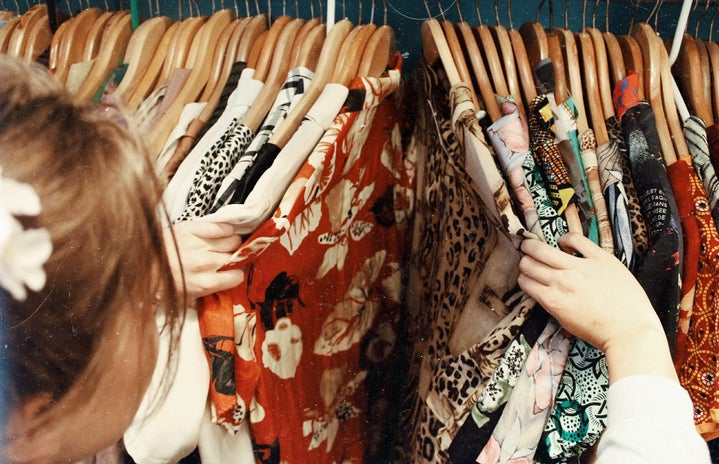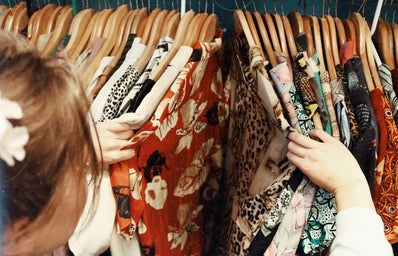As quarantine restrictions drop, the weather warms up, and more people are vaccinated, the question of what fashion will look like in spring 2021 emerges. According to the fashion and music industries, ’70s inspired-looks are in vogue. At the Grammys, Dua Lipa showed up in a dramatic Cher-inspired gown, Lana Haim, Danielle Haim, and Este Haim of HAIM in midi-dresses, Harry Styles in a plaid jacket and velvet trousers, and Anderson Paak and Bruno Mars of Silk Sonic in silk flared trousers. This reflects the call-back to ’70s inspired music on the radio — seen in Dua Lipa’s Future Nostalgia, Doja Cat’s “Say So” music video, and Silk Sonic’s “Leave the Door Open.” Spring Fashion shows exhibit a transition from the popular ’90s and y2k-looks of 2019 and 2020 and into more ’70s glam and flair.
Fashion experts say that ‘70s fashion is in season. Magazines such as Cosmopolitan and Vogue recommend purchasing bell-bottoms, bell-sleeves, and gladiator sandals. They predict that the relaxed and flowing styles of the decades will also make a comeback. Bra tops, crochet clothing, satin slips, long-sleeved flowing garments, suede, and halter tops are all expected to be popular this spring and summer.
However, TikTok, a site with great influence on youth fashion, tells a different story. TikTok is used by over 100 million users in the United States, and through its size, the platform has become the epicenter of many fashion trends. Yazmin How, TikTok’s content lead, told Vogue Business, “The fashion industry is no longer the only voice directing the new season’s trends. People are tapping into TikTok to see what emerging styles are ‘in’ and what previously popular trends are coming back around.”
Many of its creators involved in dance trends advertise a chic and relaxed style, while others specialize in a range of styles grounded in early 2000s nostalgia. This style, popularized by present and former members of The Hype House is defined by comfortable athletic street fashion. Think crop tops, high-waisted leggings and jeggings, champion hoodies, Nike Airforce No.1 sneakers, tie-dye, and matching sweatsuits, or relaxed denim styles such as cut-off or loose and distressed jeans. These clothes tend to be from brands such as depop, princesspolly, and brandymelville. But beyond this, there is also an array of other fashions that have exploded in popularity on the platform such as the “e-kid,” “cottagecore,” “dark academia,” “normcore,” “baddie,” “bimbo,” and “art hoe.” Through Tiktok’s recommendation feature and extended time at home, people are beginning to find styles that suit them and think carefully about how they want to present themselves to the world.
This has also sparked an interest in sewing, knitting, and crocheting one’s own clothes, and given rise to content creators who specialize in making their own outfits or costumes and specialize in vintage attire such as Karolina Żebrowska, Bernadette Banner, and Micarah Tewers. The explosion of interest in different fashion throughout 2020 was largely a response to the pandemic. These trends are ways to make the pandemic more manageable through craft activities, and by time indoors providing the opportunity to explore oneself. All in all, for much of the quarantine period, fashion has been a vehicle of agency — a way of staying true to oneself even within the quarantine slump.
An aesthetic is a “vibe,” or a collection of concepts that make up a theme or particular style. Morgan, the creator of the honeycore tumblr described it to The Atlantic as, “something you find beautiful that you want to incorporate and embody within your own life.” Aesthetics are about more than just clothes and can encompass music taste, attitudes, and even philosophies. Many aesthetics on TikTok are “cores.” A “core” aesthetic is a style focussed on a specific concept or image. Cottagecore, for example, is an aesthetic based around simple, pastoral living. Cottagecore apparel tends to be floral and flowing, like something you would imagine a prairie girl to wear.
“Dark academia” and its less popular companion “light academia,” are aesthetics based on the preparatory school aesthetic such as libraries and studying. The former has a more gothic and moody edge to it, evoking the ambiance of The Secret History. While the latter like the name implies presents a brighter and more romantic and optimistic approach to the prep school look and nerdy interests, it’s less murder mystery and more love story. Normcore, began as a type of anti-fashion where people intentionally wore nondescript or unfashionable items in order to be purposely uncool, but developed into a sort of campiness, where the most common fashions are taken to their extremes. Today it is a legitimate trend characterized by souvenir caps, oversized denim jackets, and blue jeans. The “baddie” is fully confident in their sexuality and is able to use the fashions of their current day in order to express their sensuality. The “bimbo” draws from dumb blond stereotypes and iconography in order to reclaim femininity and what it means to be intelligent — and what it can look like. It is a bubble-gum pink take on the baddie’s sexual liberation. The “e-kid” has two variations, the e-girl and the e-boy aesthetics. The e-girl aesthetic is derived from scene, punk, anime, and harajuku aesthetics and igari makeup, while the e-boy is more of an alternative skater aesthetic with a softboy twist. Many of these fashions have mutated into distinct categories, and provide the opportunity for people to explore a range of stylistic expressions.
Marian Park, a strategist at the trend forecasting agency WGSN told Refinery29, “What’s important to note about the abundance of micro-cores is the greater movement in youth culture towards niche aesthetics and sub-cultures. Throughout the pandemic and its isolation ennui, it’s as if a new school of creativity [has] emerged. Gen-Z are having fun defining new aesthetics and exploring fashion history and trends that connect them with each other.”
Overall, people are invested in curating styles that represent them. Moreover, it provides a sense of identity and community lost when we’re stuck at home all of the time. Angela Yin, the moderator of the aesthetics wiki explained to Refinery29, “People always ask what their aesthetic is, because they want something to define themselves. Oftentimes it can feel like so much of who we are is defined by who we know and the settings that we are in, removal from those settings provides the opportunity to question how we define and present ourselves to the world.”
Ecommerce increased 32.4 % from 2019 to 2020. Searches for cottagecore rose 900 percent between March and August of 2021, while interest in other trends skyrocketed over the course of the year.
We’re even seeing these fashions bleed further into the mainstream as pop artists adopt them, or as artists with unique styles popularized by TikTok reach mainstream prominence, seen in Taylor Swift’s cottage core and Doja Cat e-girl aesthetic respectively.
Though there are two flourishing environments of fashion, that of pop culture and that of internet culture, it is important to recognize that they are both responding to the same public issue and crisis. The pandemic has presented a set of challenges and fears, on top of a turbulent political arena, and people turn to fashion for comfort. One group of people gravitates towards the styles of the past because they long for better times, much like how people amidst the political crises of the 1990s also turned to the 1970s for fashion inspiration. At the same time, people are gravitating towards aesthetics that speak to who they are as a person, like TikTok’s core aesthetics. In general, there is a desire to reframe the 2020s according to our individual tastes and sensibilities.
What spring will look like, will depend on what it will mean to consumers. As we emerge from our quarantine cocoons, will we emerge as a distinctly authentic version of ourselves — one whose exterior matches their interior personality and interests, or as people who no longer care too much about fashion but prioritize comfort, or as architects who restructure the turmoils of our present into soothing exteriors of silk and suede? Through social media, people have discovered newfound confidence and with it, the power to shape trends as they see fit.


